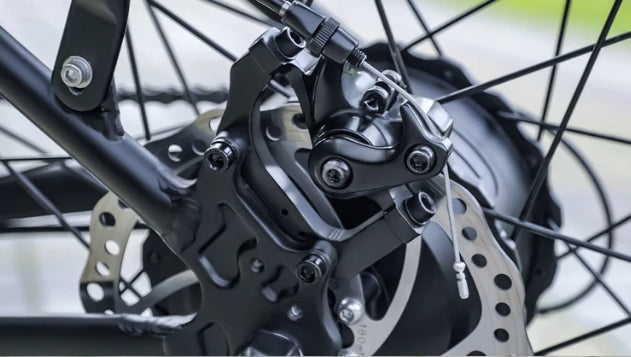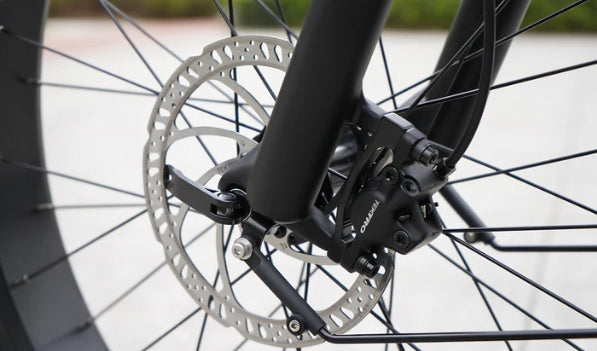The requirement for fast and efficient transportation in our daily lives is why most of us choose electric bikes over traditional bicycles. But with this upgrade comes the need for a braking system that is dependable, effective, and secure. The brakes on your electric bike are not only necessary to take charge of stopping your ride but also very important for retaining control and assuring your safety while driving.
Electric bike brake pads are one of the most important parts of these braking mechanisms, and this article aims to help you make the best choices concerning your e-bike brakes. Therefore, we'll discuss several e-bike brake types, things to consider when choosing the best brakes for your e-bike, how to maintain your bike's brakes, and suggestions for safe braking.
Types Of E-Bikes Brakes
Mechanical and hydraulic disc brakes are the two most prevalent brakes on bikes. Understanding the distinctions between different braking systems is critical for riders making an informed choice.
Mechanical Disc Brakes

Mechanical disc brakes use a cable-operated mechanism to transfer force from the brake lever to the brake caliper, which clamps down on a rotor linked to the wheel hub. When you pull the brake lever, the cable pulls the caliper, forcing the brake pads to squeeze the rotor and slow the wheel movement.
Mechanical disc brakes provide consistent stopping force and are relatively simple to maintain, making them a great choice among experienced e-bike users. However, they may necessitate more manual effort from the rider to obtain maximum braking force.
The popular Himiway Cruiser Long Range Electric Bike is a cost-effective option that runs on mechanical disc brakes since they are often less expensive. These brakes are comparatively simple to maintain and repair because they use a simple cable mechanism rather than hydraulic fluid.
Hydraulic Disc Brakes

As the name denotes, hydraulic disc brakes use a hydraulic system to transfer force from the brake lever to the brake caliper. When you pressure the brake lever, it activates a master cylinder loaded with hydraulic fluid. This fluid is then pressurized, causing the caliper pistons to force the brake pads against the rotor, producing stopping power.
Hydraulic disc brakes provide consistent and forceful braking performance with minimal rider effort. They are well-known for their superb modulation, enabling exact control over the braking force. Most Himiway electric bikes have hydraulic brakes to provide the most efficient control.
Mechanical Disc Brakes VS. Hydraulic Disc Brakes
Mechanical disc brakes are simpler technically, allowing for easy changes, and are ideal for riders who like a hands-on approach to bike maintenance. Another thing to consider about mechanical disc brakes is that they have less stopping force and modulation than hydraulic brakes, which might impact total braking performance.
Unlike mechanical disc brakes, Hydraulic disc brakes provide higher stopping power and modulation, as well as precise control and performance. The viewpoint is that hydraulic disc brakes are often more expensive than mechanical ones, potentially increasing the e-bike's overall cost. However, if you consider the ease it provides, getting an electric bicycle that runs on hydraulic disk brakes won’t be a debate. An excellent choice to check out today is the Himiway Zebra All-Terrain Electric Fat Bike.
Choosing The Right Brake For Your Electric Bike

There are a few major factors to consider when selecting the right brake for your bike. It's crucial to consider your riding style, the terrain you'll be traveling over, the riding conditions you'll experience, the cost, and the maintenance needs.
Impact of riding style and Terrain on brake selection
When choosing brakes, your riding style and the terrain you typically ride on are important considerations. You'll need brakes that can manage the demands of steep descents and give exceptional stopping power if you prefer off-road excursions, mountainous terrain, or downhill riding. You will need an all-terrain electric bike with a hydraulic disc brake.
Due to their greater modulation and reliable functioning in such circumstances, hydraulic disc brakes are greatly recommended. Mechanical disc brakes may be a good option for smooth rides or city commuting as they offer sufficient stopping force for most riding circumstances.
How riding conditions can affect the choice of brakes
Also, think about the environment and weather where you ride your e-bike the most. Hydraulic disc brakes typically operate better if you frequently drive in muddy or rainy situations because of their sealed design, which helps prevent water and debris from compromising their performance. Even if they are capable, mechanical disc brakes may need more frequent cleaning and maintenance to ensure maximum performance in these circumstances.
Role of cost and maintenance in selecting the best brake for your e-bike
Other important factors to consider are the cost and required continuous maintenance. Since they rely on a more straightforward cable-operated system, mechanical disc brakes are typically cheaper upfront and simpler to maintain. Although they may be serviced with simple equipment, they need frequent adjustments to consider cable stretch.
Hydraulic disc brakes normally cost more upfront, but over time they function better and require less maintenance. However, if brake line repairs or bleeding are necessary, using specialized equipment and experience would raise the cost of general maintenance.
Finally, your tastes influence your choices. Some riders may like the "feel" and control of hydraulic disc brakes, praising their smooth modulation and easy operation. Others may like the mechanical disc brakes' simplicity and familiarity. It is critical to test-ride electric bikes equipped with several brake systems to determine how they operate and which one feels the most comfortable to you.
How To Maintain Your Electric Bike Brakes
Routine maintenance is essential for your e-bike brakes to function at their best. Your brakes will deliver dependable stopping power and increase riding safety if you take the necessary precautions and care for them.
Regular Cleaning Maintenance
Cleaning your brake calipers and rotors regularly with a soft brush or cloth will help remove dust, dirt, and brake fluid. Be careful not to use harsh chemicals that can harm brake parts. Allow lubrication to occur frequently, if not weekly. Lubricate moving components, such as brake levers and cables, to ensure smooth operation. Utilize lubricant with a silicone base that has been approved for bike parts.
To guarantee consistent contact with the braking rotor, check and correct the alignment of the brake pads. Properly positioned brake pads increase the effectiveness of the brakes and wear. Look for wear, kinks, or damage regularly when checking brake cables, hoses, and hydraulic lines. Any faulty parts must be replaced right away.
Look out for wear and tear signs
If you experience any unusual noises while braking, such as screeching or grinding, it's likely that your brake pads need to be replaced. Also, If your vehicle's stopping power has decreased, it may be due to dirty brake rotors or worn brake pads. For example, a spongy brake lever in a hydraulic system may indicate that air is present in the lines and that bleeding is necessary.
When braking, you must pay attention to any minor noises you notice. You should contact a professional specialist for repair if the issue is more complex than the most basic one.
How To Change Brake Pads And Discs
1. Assemble the required equipment and supplies
The required tools and materials should be available before the brake pad and disc replacement procedure begins. Replacement brake discs, new brake pads, and the Allen or Torx key are needed to remove or reinstall the brake caliper. You will also need a clean cloth.
2. Set up your bike and work area
Locate a spot that is tidy and well-lit to work on your e-bike. It could be useful to support the rear wheel or use a bike stand to keep it upright when changing the rear brake pads. Before continuing, make sure your bike is steady and safe.
3. Remove the old brake pad
Find the brake caliper mounted on your bike's front fork or rear chain stay. To remove the old brake pads, use this order. Firstly, use the proper tool to loosen the caliper mounting bolts. The old brake pads should then be carefully removed from the caliper.
4. Inspect the brake discs
It's a good idea to check them for wear and damage now that the old brake pads have been removed. Check the disc surface for any indications of scoring, warping, or severe wear. Replacing the disc with a fresh one is advised if it appears overly worn or damaged.
5. Replace the brake pads
Insert the new brake pads into the caliper. Ensure the pads are properly aligned and firmly inserted in the caliper slots. Apply mild pressure to ensure they are securely in place.
6. Alignment of the brake disc
If necessary, slightly modify the brake pad alignment to ensure even contact with the brake disc. If you detect uneven wear or believe the pads are not properly aligned, loosen the caliper mounting nuts slightly. Check and, if necessary, modify the alignment of the brake discs. If you observe any disc wobbling or rubbing against the brake pads, it may need to be adjusted. Inspect the distance between the brake disc and each brake pad. They should be equal on both sides. You can use an adjustable wrench to realign the disc if it appears misaligned.
Bleeding Hydraulic Brakes
Ensure you have the proper brake bleeding equipment and follow the manufacturer's instructions before attempting to bleed hydraulic brakes.
1. Fill the syringe with new brake fluid from the reservoir. Make sure there are no air bubbles in the syringe. Connect the syringe to the opposite end of the bleed kit tubing.
2. Place the other end of the tube in the plastic bag or container to catch the old brake fluid. Begin the bleeding procedure by slowly and carefully squeezing the brake lever a few times and holding it in that position.
3. While holding the lever, slightly open the bleed port on the caliper, allowing the old brake fluid and air bubbles to be pushed through the tube.
4. Before releasing the brake lever, close the bleed port. Repeat compressing the brake lever, opening and closing the bleed port until no air bubbles are seen in the brake fluid, and the fluid seems clean.
5. To prevent air from entering the system, keep the braking fluid level in the reservoir above the minimum fill line throughout the bleeding process.
6. When the bleeding is finished, remove the syringe from the bleed kit tubing and close the caliper's bleed port. Clean any spilled brake fluid from the bike with a cloth or paper towel.
Tips For Safe Braking With Your E-Bike
Knowing the right procedures and correctly using your brakes will prevent accidents and guarantee a comfortable ride. Here are some ways to safely use your e-bike brakes:
Proper use of both brakes for effective braking
The proper way to use both brakes is to do it simultaneously for the best braking results. Himiway electric bikes come with front and rear brakes, normally controlled by different brake levers. Evenly using both brakes spreads the braking force and lowers the possibility of skidding.
Correct positioning of hands while braking
Keep your hands close to the brake levers and maintain a strong hold on the handlebars when braking. This makes it possible to quickly and instantly access the brakes when necessary. Be careful not to hold the handlebars too tightly, which could influence your overall sense of control and maneuverability.
Safe braking techniques for different situations
Remember that the front brake often has higher stopping strength to avoid a potential flip-over. Use both brakes firmly and gradually if an unforeseen hazard or obstruction arises. To enhance the effectiveness of the rear brake and prevent the front wheel from slipping, shift your body weight slightly to the rear. On a steep downhill, severe and prolonged braking might produce heat and lessen the efficiency of the brakes. To prevent skidding on slick surfaces, slow down and gently and smoothly apply the brakes. In these circumstances, give yourself extra space and time to halt.
Awareness of surrounding conditions while braking
When braking, pay attention to your surroundings. Pay attention to the flow of traffic, pedestrians, the state of the roads, and any potential dangers. To ensure a safe and controlled stop, anticipate the need to brake and reduce your speed accordingly.
Conclusion
The significance of electric bike brakes cannot be understated when it comes to guaranteeing safety and optimal performance. Brake pads are essential for stopping power, reactivity, and overall control of your e-bike. Consider compatibility, riding style, and terrain while getting a new bike. Choose high-quality pads that provide the desired performance, longevity, and modulation.
By prioritizing brake maintenance, you may enjoy safe and confident bike rides. Inspect the brake pads for wear regularly and replace them as necessary. It is critical to remain cautious and pay close attention to the care of your brakes. Remember that safe riding begins with reliable brakes; give them the attention they deserve to improve your riding pleasure and secure your safety.














































